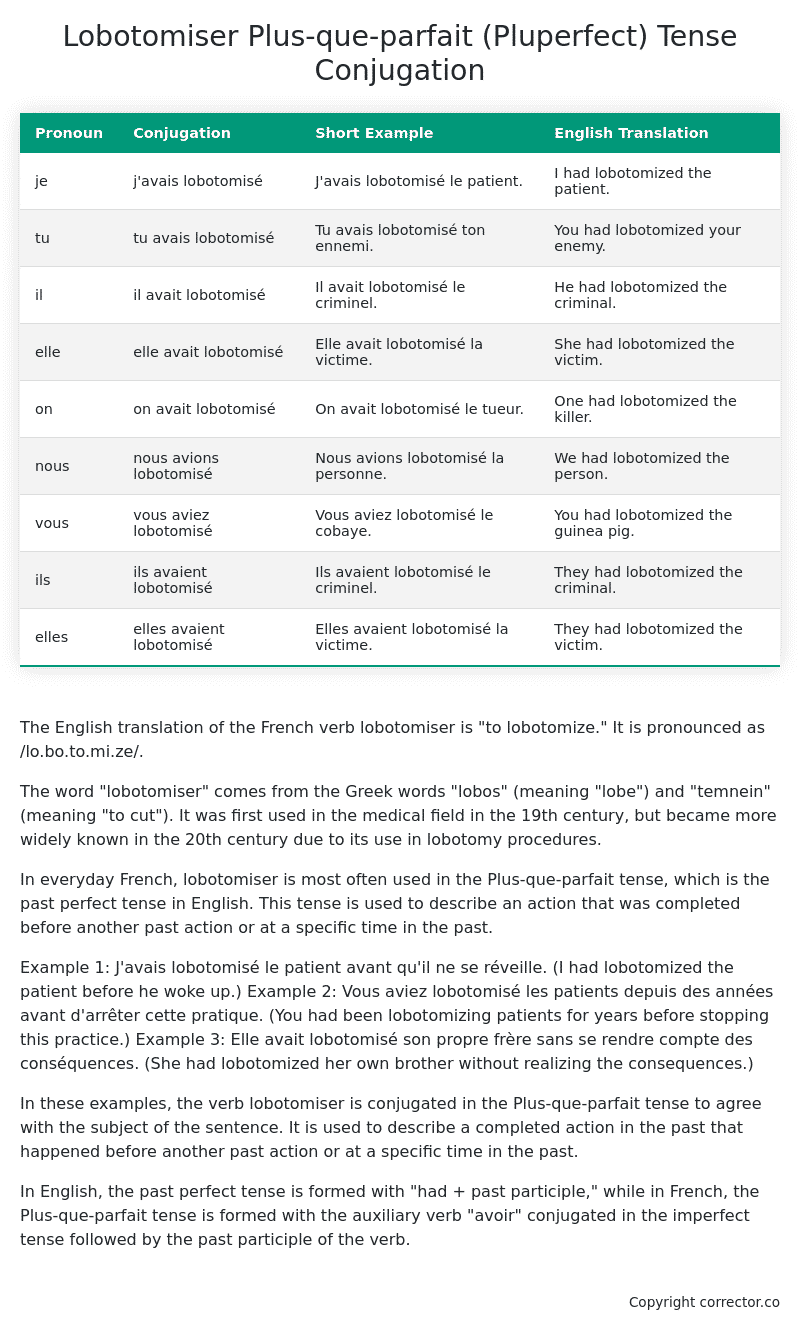Plus-que-parfait (Pluperfect) Tense Conjugation of the French Verb lobotomiser
Introduction to the verb lobotomiser
The English translation of the French verb lobotomiser is “to lobotomize.” It is pronounced as /lo.bo.to.mi.ze/.
The word “lobotomiser” comes from the Greek words “lobos” (meaning “lobe”) and “temnein” (meaning “to cut”). It was first used in the medical field in the 19th century, but became more widely known in the 20th century due to its use in lobotomy procedures.
In everyday French, lobotomiser is most often used in the Plus-que-parfait tense, which is the past perfect tense in English. This tense is used to describe an action that was completed before another past action or at a specific time in the past.
Example 1: J’avais lobotomisé le patient avant qu’il ne se réveille. (I had lobotomized the patient before he woke up.)
Example 2: Vous aviez lobotomisé les patients depuis des années avant d’arrêter cette pratique. (You had been lobotomizing patients for years before stopping this practice.)
Example 3: Elle avait lobotomisé son propre frère sans se rendre compte des conséquences. (She had lobotomized her own brother without realizing the consequences.)
In these examples, the verb lobotomiser is conjugated in the Plus-que-parfait tense to agree with the subject of the sentence. It is used to describe a completed action in the past that happened before another past action or at a specific time in the past.
In English, the past perfect tense is formed with “had + past participle,” while in French, the Plus-que-parfait tense is formed with the auxiliary verb “avoir” conjugated in the imperfect tense followed by the past participle of the verb.
Table of the Plus-que-parfait (Pluperfect) Tense Conjugation of lobotomiser
| Pronoun | Conjugation | Short Example | English Translation |
|---|---|---|---|
| je | j’avais lobotomisé | J’avais lobotomisé le patient. | I had lobotomized the patient. |
| tu | tu avais lobotomisé | Tu avais lobotomisé ton ennemi. | You had lobotomized your enemy. |
| il | il avait lobotomisé | Il avait lobotomisé le criminel. | He had lobotomized the criminal. |
| elle | elle avait lobotomisé | Elle avait lobotomisé la victime. | She had lobotomized the victim. |
| on | on avait lobotomisé | On avait lobotomisé le tueur. | One had lobotomized the killer. |
| nous | nous avions lobotomisé | Nous avions lobotomisé la personne. | We had lobotomized the person. |
| vous | vous aviez lobotomisé | Vous aviez lobotomisé le cobaye. | You had lobotomized the guinea pig. |
| ils | ils avaient lobotomisé | Ils avaient lobotomisé le criminel. | They had lobotomized the criminal. |
| elles | elles avaient lobotomisé | Elles avaient lobotomisé la victime. | They had lobotomized the victim. |
Other Conjugations for Lobotomiser.
Le Present (Present Tense) Conjugation of the French Verb lobotomiser
Imparfait (Imperfect) Tense Conjugation of the French Verb lobotomiser
Passé Simple (Simple Past) Tense Conjugation of the French Verb lobotomiser
Passé Composé (Present Perfect) Tense Conjugation of the French Verb lobotomiser
Futur Simple (Simple Future) Tense Conjugation of the French Verb lobotomiser
Futur Proche (Near Future) Tense Conjugation of the French Verb lobotomiser
Plus-que-parfait (Pluperfect) Tense Conjugation of the French Verb lobotomiser (this article)
Passé Antérieur (Past Anterior) Tense Conjugation of the French Verb lobotomiser
Futur Antérieur (Future Anterior) Tense Conjugation of the French Verb lobotomiser
Subjonctif Présent (Subjunctive Present) Tense Conjugation of the French Verb lobotomiser
Subjonctif Passé (Subjunctive Past) Tense Conjugation of the French Verb lobotomiser
Subjonctif Imparfait (Subjunctive Imperfect) Tense Conjugation of the French Verb lobotomiser
Conditionnel Présent (Conditional Present) Tense Conjugation of the French Verb lobotomiser
Conditionnel Passé (Conditional Past) Tense Conjugation of the French Verb lobotomiser
L’impératif Présent (Imperative Present) Tense Conjugation of the French Verb lobotomiser
L’infinitif Présent (Infinitive Present) Tense Conjugation of the French Verb lobotomiser
Struggling with French verbs or the language in general? Why not use our free French Grammar Checker – no registration required!
Get a FREE Download Study Sheet of this Conjugation 🔥
Simply right click the image below, click “save image” and get your free reference for the lobotomiser Plus-que-parfait tense conjugation!

Lobotomiser – About the French Plus-que-parfait (Pluperfect) Tense
Tense Formation
Common everyday usage patterns
Sequencing of past events
Background information
Hypothetical or reported speech
Interactions with other tenses
Summary
I hope you enjoyed this article on the verb lobotomiser. Still in a learning mood? Check out another TOTALLY random French verb conjugation!


